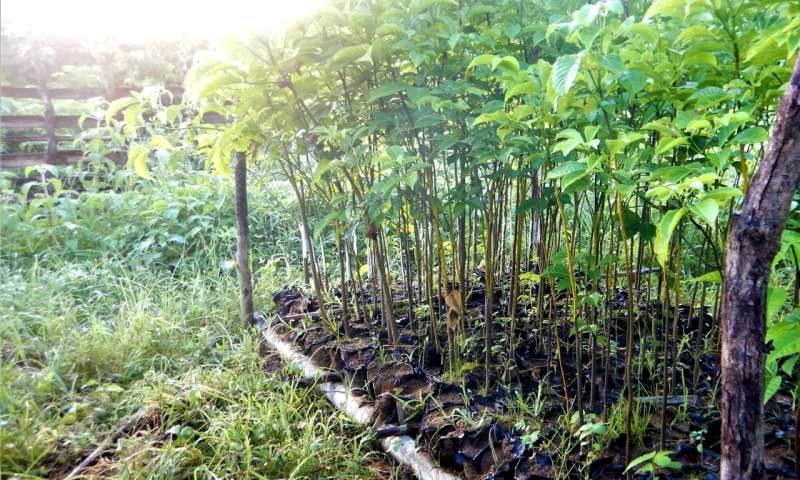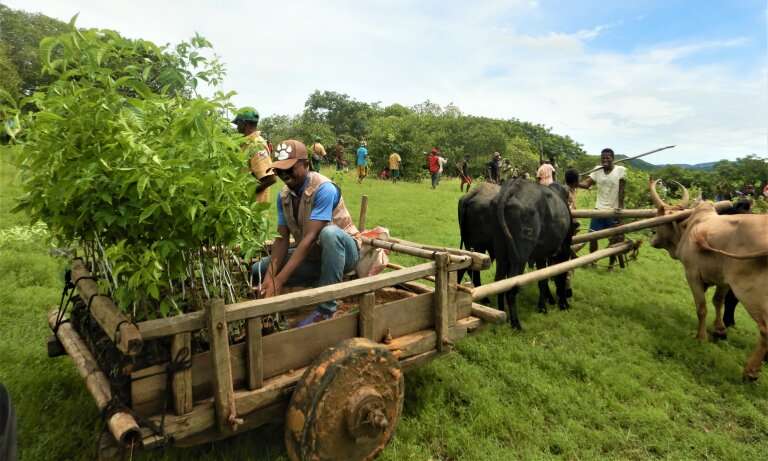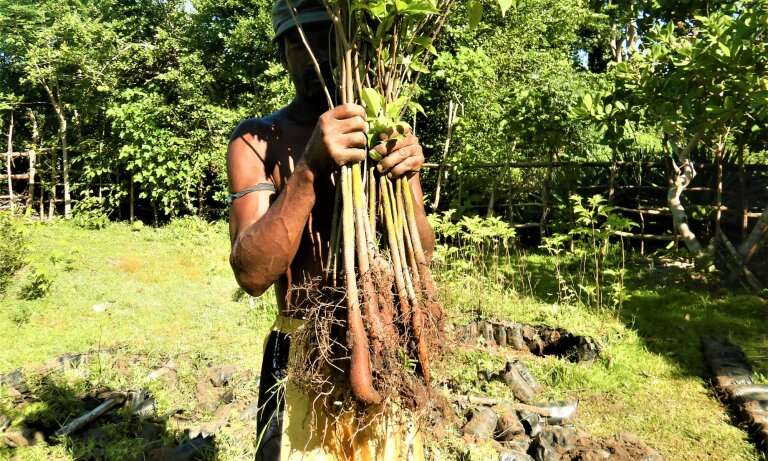Credit: Tonisoa Ranaivo/Madagasikara Voakajy
Even giant trees begin their life as humble seeds.
Seeds—perfectly adapted packages containing all the requirements to kick-start a plant's journey in the world—can be fussy. Although many will simply spring to life days after being sown, others are not so cooperative. For some species, including the critically endangered Perrier's baobab, it takes true detective work to figure out the secret to successful germination.
This was the challenge that Madagasikara Voakajy (MV), long-time partner of Fauna & Flora International (FFI) in Madagascar, embraced in 2016. Methods mimicking passage through an animal's gut—including chipping away at the hard outer seed coat and soaking in acid—were trialled, with some success. But MV's scientists found the best way to encourage germination of Perrier's baobab seeds was giving them a hot bath in boiling water for precisely 16 seconds, which resulted in between 85 and 90% germination. The puzzle was solved.
Since then, MV has been supporting local communities to grow Perrier's baobab plants for reintroduction—a vital approach given the species' low seedling recruitment in the wild and dwindling number of adult trees. Land conversion to agriculture and gold mining have reduced the global population—confined to a handful of sites across northern Madagascar—to just 162 individual trees.
Troublesome transplanting
Following at least eight months of nursery day care, Perrier's baobab seedlings are ready to graduate to their final growing locations within Loky-Manambato Protected Area at Madagascar's northern tip. With planting sites chosen for their favourable current and predicted future climate and as the locations of historic populations, 4,600 Perrier's baobab seedlings were prepared and loaded onto trucks for transportation in early 2019. Despite high initial losses in transit, 90% of the 2,526 seedlings present in June 2019 survived late into the year and 2,258 saplings are now establishing themselves across the two planting sites.
Data for thought
But MV doesn't abandon these Perrier's baobab saplings once they're in the ground—ongoing monitoring of each tree provides feedback on how factors such as transplantation method, planting site and seed origin affect survival.
Transporting baobab seedlings to planting sites within Loky-Manambato Protected Area. Credit: Tonisoa Ranaivo/Madagasikara Voakajy
Pot-less transplantation was trialled as a potentially easier way to transport the huge numbers of seedlings, as pots add bulk and weight. Subsequent monthly monitoring by MV staff has shown that there is no significant drop in survival rate when seedlings are transported with their roots exposed, meaning that future plantings can adopt this simpler and quicker pot-less transplantation.
Data from a previous Perrier's baobab planting trial in 2014 suggest that regeneration may be more successful when seedlings are planted in shrubby savannah rather than forest. This is thought to be due to higher light levels in savannah compared to closed-canopy forest. These results can inform future planting, which should help ensure higher survival rates going forward.
To protect these fledgling trees, Malagasy NGO Fanamby supports communities living near the planting sites to monitor potential threats including land burning for agriculture and livestock grazing. MV has worked with Fanamby to promote this work, using its local radio show, Feon-Akomba, to reach many community members, ensuring that they are aware of the planting initiatives and the need to protect Perrier's baobabs.
Exposed roots of Perrier’s baobab seedlings. Credit: Tonisa Ranaivo/Madagasikara Voakajy
Onwards and upwards
February 2020 saw another round of Perrier's baobab seedlings being transplanted. Across two more sites in Loky-Manambato Protected Area, 2,061 seedlings were planted and ongoing monitoring will once again be an important part of MV's work to support these and future trees to reach maturity.
MV's approach to continuously seeking feedback to inform better restoration practices is admirable and greatly needed. With many factors surrounding baobab seed germination and seedling survival, data collected by the team can be shared with other local groups to scale up planting efforts and enable high survival rates to continue into future planting seasons.
Tonisoa Ranaivo, Baobab Project Officer at MV, sums up the trees' plight perfectly: "Even though baobab trees live for hundreds of years, they are struggling to survive independently… they need our help to prevent their extinction."
This work forms part of the Global Trees Campaign, a joint initiative led by FFI and Botanic Gardens Conservation International in association with other partners around the world, working to secure the future of the world's threatened tree species in situ.
Provided by Fauna & Flora International

























